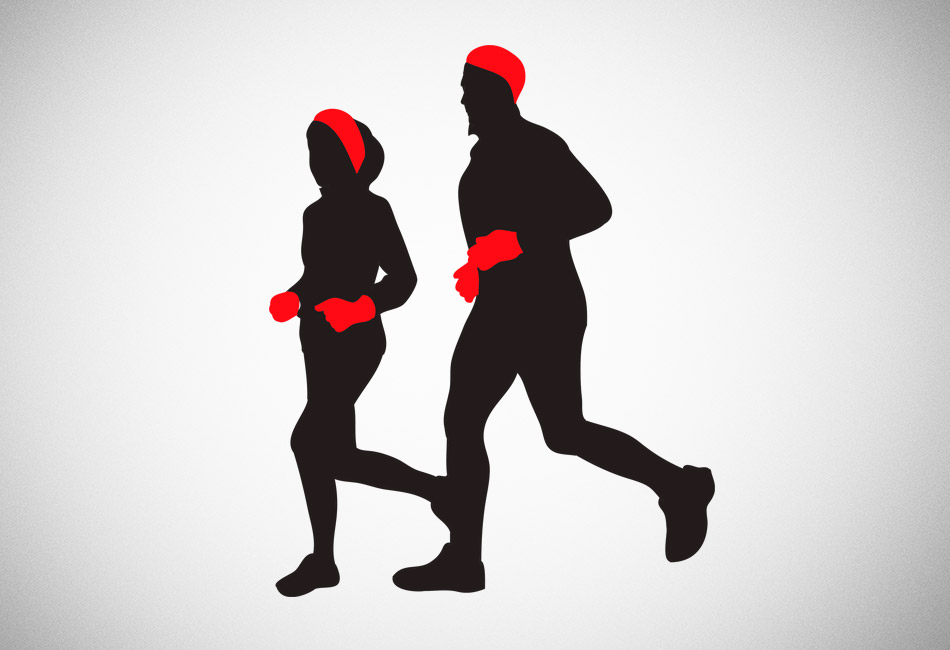The moment the outside temperature drops a few degrees all the tempting voices that tell us we should be warm, comfortable and inside become louder and our training begins to look increasingly patchy. Add all these feelings of discomfort to the persistent myth than training in cold weather makes you more likely to catch a cold and it’s no wonder that there is so much pressure to catch up on training the moment Spring arrives.
Yet, cold weather may be Mother Nature’s way of helping us superboost our training performance or, way more likely, our bodies have adopted to perform really well in cold weather. Despite the fact that we have relatively little fur and no way of comfortably storing adipose fat to act as insulation without also affecting our physical performance, the prevalence of ice ages in our prehistoric past has given us a body that takes cold in its stride.
So, let’s look at the …ahem, cold, hard facts and see what’s the best way to use winter to our benefit.
Temperature is key to performance
Of all the animals we are designed to run long distances best because our bodies are the most efficient when it comes to cooling down our muscles. Excessive muscle temperature then is one of the biggest performance killers there is. Research carried out by the United States Army Research Institute of Environmental Medicine on marathon runners showed that the best times for elite marathon runners were clocked when the temperature was 41 – 50 degrees Fahrenheit (between 5 and 10 degrees Celsius).
Cold weather acts as a natural heat dissipater that allows us to train longer without overheating so muscle performance is a lot smoother. But the benefits of training in lower temperatures do not stop there. Our respiratory system is designed to warm each breath of air we take to blood temperature. When the weather is cold outside our nose, throat and lungs have to work harder. Lungs, in particular, have to expand more fully using every capillary they have to warm up the air we breathe. As a result cold weather acts as a stimulus to increase VO2 max (the optimal oxygen uptake with each breath we take) and increases the building of aerobic structures in muscles that help increase our endurance in running.
More than that a study by the Mayo Foundation for Medical Education and Research discovered that regular outdoors exercise in the cold reduced the risk of flu susceptibility by 20-30%. Cold weather boosts circulation, increases lung performance and raises the metabolism and all of these, combined, have a beneficent effect on the immune system.
Burn Fat, Faster and Fight Colds
A research medical team led by Dr. Francesco S. Celi of Virginia Commonwealth University and Dr. Paul Lee, now at the Garvan Institute of Medical Research in Australia, explored the effects of ambient temperature on brown fat and metabolism. What they found was that regular exposure to low temperatures while training changed the way the body processed fat reserves.
After a month of exposure to mild cold, the participants had a 42% increase in brown fat volume and a 10% increase in fat metabolic activity. They also exhibited improved insulin sensitivity after a meal. Prolonged exposure to mild cold also resulted in significant changes in metabolic hormones such as leptin and adiponectin. There were no changes in body composition or calorie intake.
Regular exposure to low temperatures then helps our bodies become leaner and fitter. They learn to make better use of fat reserves and burn excess fat intake faster.
Spartan warriors, badass role models throughout the ages, knew well the benefits of cold water training and low temperatures. They wore the same, sparse clothes even during Sparta’s harsh winters and held regular contests of who could last the longest bathing under a natural cold spring gushing from the mountains around their home.
A number of additional studies have shown that starting the day with a cold shower lowers stress levels, boosts testosterone and provides an energy boost for the rest of the day and that those who take cold showers in winter enjoy greater immune protection against colds and the flu.
Despite all the benefits training in cold weather (or taking a short cold shower) is definitely a shock to the body so it’s important to look at the mechanics that drive our physiological response to cold: researchers at Japan's National Defence Medical College have shown that exposure to cold air enhances the activity of 'suppressor macrophages' which suppress the immune system. In addition the initial stress of the cold on the body produces a hormonal response from the “stress hormone” hydrocostisone (cortisol) which further depresses the immune system and raises the possibility of getting a cold.
This is why, despite the fact that we all know that colds and flus come from viruses and contact with people, we still say that training in the cold will make it more likely you catch a chill. What happens is that we usually already have a viral infection in our bodies which the immune system is keeping at bay. The increased cold stress suffered by the body, dampens the immune system response and makes it easier for the virus we already have to temporarily gain the upper hand.
Luckily, the same research showed that regular exposure to low temperature training triggers the adaptive response of the body and hardens it to the cold, strengthening its autoimmune system response and making it less likely that it will get infections.
Cold Weather Training Basics
As Rocky showed us when he trained in the cold snows of Russia for his bout with the hulking Ivan Drago, training in cold weather can pay off provided we follow some common sense basics:
- Dress in layers – the body generates a lot of heat even during cold weather. It’s important to dress to keep the muscles warm initially but be able to let them cool down faster when we get going. Wear layers that will help you keep warm but which you can peel off as you run to help maintain a balanced temperature.
- Wear a cap and mits – when it comes to feeling the cold our head and our hands suffer the most. Wear a wooly cap or a baseball cap to protect your head against the cold and make sure you wear gloves to help keep your fingers protected from the excesses of the cold.
- Warm up well – our warm up routine is even more important when running in the cold than at any other time. While the temptation may be to just get going, resist it. It is important we warm up our extremities to get our bodies used to the temperature and boost circulation.
- Remain hydrated – running in cold weather drains almost as much moisture from our bodies as running in hot weather. It is important we stay hydrated during long runs or prolonged periods of exercise.
- Do not get sweaty and chilled – the moment we stop we should wrap up to help our bodies remain as warm as possible. Sweat compromises the skin’s insulating properties and makes it more likely that our body will experience deep chills that will generate a cold stress response (i.e. dampened immune system).
- Keep an eye on the wind – the wind chill factor is separate to what the temperature reading is on the thermometer. Wind blows away the thermal layer of heat that emanates from our bodies as we run and cools us down faster, making it hard to maintain core temperature. That’s why a windy day with five degrees centigrade temperature can feel subzero when we are out in it.
Just because it’s cold outside does not mean we need to hibernate. With some common sense precautions we can continue to train and use the lower outside temperatures to boost our body’s immune response and our overall fitness levels. Running in cold weather is probably one of the easiest ways there are to maximize the benefits we get from exercise.
Sources
Everything You Know About Marathons Is Wrong
Cold exposure increases running VO(2max)
Cool Temperature Alters Human Fat and Metabolism
Moderate exercise in mice boosts immune system, diminishes flu's severity
Boosting Your Flu Shot Response With Exercise
Cold Showers Offer More than You May Think
Physiological and Leukocyte subset responses to exercise and cold exposure










